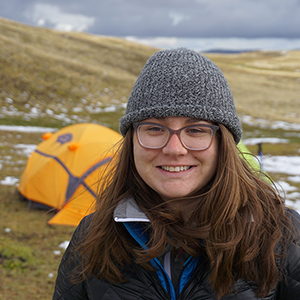Collection Manager, Paleobiology

Biography
Sarah Davis is a paleontologist and evolutionary biologist. Davis received her PhD in Geosciences from the University of Texas at Austin in 2022, and her BS and BA from the University of Arizona in 2016. She also worked as a collection assistant and researcher at the UT Austin Vertebrate Paleontology and Modern Osteology collections.
Davis studies the evolution of birds, with an emphasis on avian diversity and recovery surrounding the K/Pg mass extinction event. She has collaborated on field work in Chile to investigate Late Cretaceous faunal assemblages and the impacts of the extinction event at southern high latitudes, as well as field work in the southwestern United States and China. She has described fossils from Texas, Chile, and Antarctica, and has ongoing projects in these areas.
In addition to her work on fossils, Davis investigates the evolution of color: how it has evolved in living archosaurs (bids and crocodilians), and how this can help to decipher coloration in extinct dinosaurs. To do this she combines data from living animals with information from fossils that have soft tissue preservation.
Davis is also passionate about science outreach and making collections widely accessible. Her love of science first began with museums, which motivated her to develop educational activities that emphasize museum collections for use in classrooms and museum spaces. She has collaborated with educators, artists, and science writers to bring scientific discoveries to broad audiences and is excited to continue these efforts at the Carnegie Museum of Natural History.
Publications
Davis, S.N., Soto-Acuña, S., Fernández, R.A., Amudeo, J., Leppe, M.A., Rubilar-Rogers, D., Vargas, A.O., and Clarke, J.A. 2023. New Records of Theropoda from a Late Cretaceous (Campanian-Maastrichtian) locality, Magallanes-Austral Basin, Patagonia, and insights into end Cretaceous theropod diversity. Journal of South American Earth Sciences, 122: 104163.
Davis, S.N., and Clarke, J.A. 2022. Estimating the distribution of carotenoid coloration in skin and integumentary structures of birds and extinct dinosaurs. Evolution, 76(1): 42–57.
Legendre, L.J., Rubilar-Rogers, D., Musser, G.M., Davis, S.N., Otero, R.A., Vargas, A.O., and Clarke, J.A. 2020. A giant, soft-shelled egg from the Late Cretaceous of Antarctica. Nature, 583(7816): 411-414.
Davis, S.N., Torres, C.R., Musser, G.M., Proffitt, J.V., Crouch, N.M.A., Lundelius, E.L., Lamanna, M.C., and Clarke, J.A. 2020. New mammalian and avian records from the Late Eocene La Meseta and Submeseta Formations of Seymour Island, Antarctica. PeerJ, 8: e8268.
George, S.W.M., Davis, S.N., Fernández, R.A., Manríquez, L.M.E., Leppe, M.A., Horton, B.K., Clarke, J.A. 2020. Chronology of deposition and unconformity development across the Cretaceous-Paleogene boundary, Magallanes-Austral Basin, Patagonian Andes. Journal of South American Earth Sciences, 97: 102237.
Higginson, D.M., V. Belloni, S.N. Davis, E. S. Morrison, J.E. Andrews, and A.V. Badyaev. 2016. Evolution of long-term coloration trends with biochemically unstable ingredients. Proceedings of Royal Society, Biological Sciences. Lond. 283 (1831): 20160403
